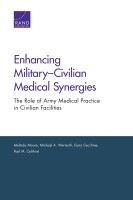| 来源类型 | Research Reports
|
| 规范类型 | 报告
|
| DOI | https://doi.org/10.7249/RR1313
|
| ISBN | 9780833092229
|
| 来源ID | RR-1313-A
|
| Enhancing Military–Civilian Medical Synergies: The Role of Army Medical Practice in Civilian Facilities |
| Melinda Moore; Michael A. Wermuth; Gary Cecchine; Paul Colthirst
|
| 发表日期 | 2016
|
| 出版年 | 2016
|
| 页码 | 156
|
| 语种 | 英语
|
| 结论 |
Stakeholders Widely See Resource-Sharing Agreements as Beneficial- MTFs and local counterparts that use such agreements universally find them mutually beneficial, although the MTFs find the guidance documents outdated, insufficient, and in need of updating.
- Military stakeholders reported benefits to the Army that include better access, quality, and continuity of care for beneficiaries; proficiency maintenance and exposure to industry best practices for military professionals; and perceived cost savings to TRICARE.
- Benefits that local civilian counterparts cited included revenue generation (TRICARE payment for beneficiary care) and more-productive utilization of their infrastructure by military personnel.
- The strong consensus among military and civilian users and leaders regarding the benefits of external medical practice suggests that such practice is warranted when both the MTF and local partner can justify it in their respective business plans.
|
| 摘要 |
- Update Office of the Surgeon General and U.S. Army Medical Command policy guidance for external resource-sharing agreements (ERSAs) and gratuitous training agreements.
- Identify appropriate proponents for ERSAs and for gratuitous training agreements.
- In the short term, identify potential untapped opportunities for external practice, especially ERSAs, and encourage their use when justifiable in MTF business plans.
- For longer-term policy purposes, conduct a quantitative assessment of the costs and potential efficiencies associated with care provided in the Military Health System compared with those of different civilian options, such as those examined in this initial qualitative study.
- If warranted following such analysis, encourage the expansion of agreements to include a wider range of Army medical professionals and medical teams.
- Maintain the current decentralized management scheme, but consider a mechanism for central visibility of agreements.
- Facilitate mechanisms to share experiences and learn lessons about different types of sharing and training agreements.
|
| 主题 | Defense Health Agency
; Health Care Facilities
; Medical Professionals
; United States Army
|
| URL | https://www.rand.org/pubs/research_reports/RR1313.html
|
| 来源智库 | RAND Corporation (United States)
|
| 引用统计 |
|
| 资源类型 | 智库出版物
|
| 条目标识符 | http://119.78.100.153/handle/2XGU8XDN/108337
|
推荐引用方式
GB/T 7714 |
Melinda Moore,Michael A. Wermuth,Gary Cecchine,等. Enhancing Military–Civilian Medical Synergies: The Role of Army Medical Practice in Civilian Facilities. 2016.
|
|
文件名:
|
x1495316313554.jpg
|
|
格式:
|
JPEG
|

|
文件名:
|
RAND_RR1313.pdf
|
|
格式:
|
Adobe PDF
|
除非特别说明,本系统中所有内容都受版权保护,并保留所有权利。